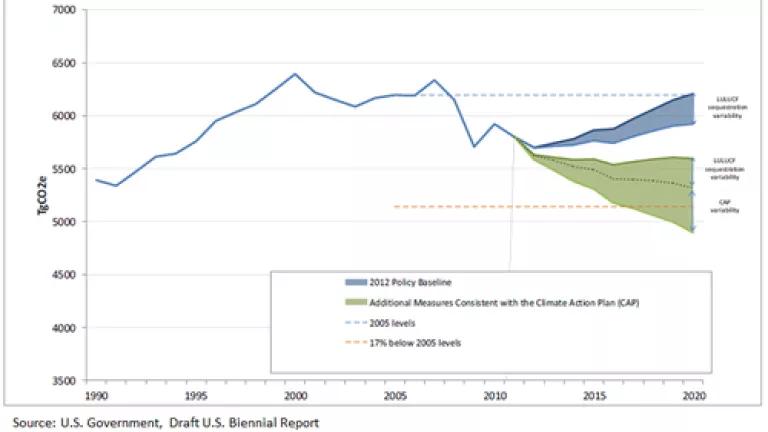
The U.S. can reduce its climate pollution by implementing the actions in President Obama’s Climate Action Plan. That is the finding of an official U.S. government report on progress in meeting its climate target. When President Obama released the climate action plan last June, he set out a clear benchmark for his administration – make sure that the measures in the plan add up to reducing total greenhouse gases 17 percent below 2005 levels by 2020 – the target he committed to as a part of the Copenhagen Climate Summit in 2009. This report shows that strong implementation of this action plan can meet this target.
The report – the U.S. Climate Action Report – found that total U.S. emissions will be 14-20 percent below 2005 levels in 2020 if the Obama Administration implements the climate action plan (see figure).
Here are some of the key next steps to meet that target.
Controlling carbon pollution from power plants. America’s power plants account for 40 percent of U.S. carbon pollution, so the steps the Environmental Protection Agency (EPA) takes under existing law will go a long way towards meeting this climate target. As a part of the climate action plan, President Obama issued a memorandum with a specific schedule to make sure that the EPA finalizes carbon pollution standards for power plants before he leaves office. EPA has taken the first step in this direction by proposing carbon pollution controls for new power plants. Over 3.2 million Americans have already raised their voices in support of carbon pollution standards for both new and existing plants, so the President has strong support to take the next step – set carbon pollution limits on existing power plants.
NRDC outlined a specific proposal towards this effort. We found that this proposal would cut U.S. power sector carbon pollution 26 percent below 2005 levels in 2020 and 34 percent by 2025. We can take this step while creating more than 200,000 new jobs, trimming electricity bills and helping our economy, as a recent NRDC report found.
Reducing the “super greenhouse gases” – HFCs. The super pollutants known as hydrofluorocarbons (HFCs) carry a heat-trapping punch thousands of time that of CO2. Left uncontrolled, EPA estimates that these emissions will increase by over 60 percent in 2020 and 134 percent in 2030. To help address this growth the U.S. joined with Mexico and Canada to propose a global HFC phase-down under the Montreal Protocol. This global effort got a recent boost when the G20 countries agreed to phase-down these pollutants.
The President’s action plan also includes a clear signal that the U.S. is going to reduce the growth of these pollutants through the Clean Air Act. NRDC and other groups have petitioned EPA with a common sense proposal – EPA should create an “in with the new, out with the old” policy where the current refrigerants used in air conditioners and refrigerators are replaced with refrigerants that are less potent at causing climate change.
Spurring energy efficiency and renewables. With clean energy from wind, solar, and energy efficiency booming the President’s plan correctly focuses on setting additional appliance efficiency standards, reducing building energy use, and spurring renewable energy. Towards this objective the Department of Energy has committed to push forward four delayed energy efficiency standards.
Minimizing methane leakage. Unburned methane that leaks into the atmosphere is significantly more powerful at trapping heat than CO2, so even a little methane leakage is a problem. America’s natural gas system has leaks that must be brought under control. Technologies to reduce methane leaks are available and often profitable, as NRDC showed last year. We can an must ensure than methane leaks are well below one percent of production.
EPA issued regulations in 2012 to require that most fracked natural gas wells will have to capture or flare methane during well completions staring in 2015. These standards would be even more effective if they were implemented sooner, applied to existing wells, and extended to oil wells and hybrid wells that produce a combination of oil and gas. The President’s climate action plan identifies these emissions as an area where they are working on further actions.
------------------------
This report reaffirms the importance of strong domestic action by President Obama to curb global warming pollution using existing U.S. law. Implementation of this action plan will put the U.S. on track to meet the target that the President committed to in Copenhagen and help build confidence for even greater action in 2015 when countries are set to agree on the next round of global warming pollution cuts.

